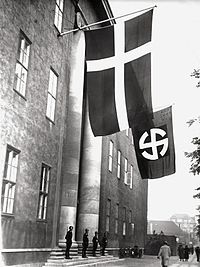Germanic-SS

The Germanic-SS were foreign agencies of the Allgemeine-SS.
|
|
 Headquarters of the Schalburg Corps in Copenhagen, Denmark, c.1943. |
|
| Agency overview | |
|---|---|
| Formed | September, 1939 |
| Dissolved | May 8, 1945 |
| Jurisdiction |
Occupied Europe |
| Headquarters |
SS-Hauptamt, Prinz-Albrecht-Straße, Berlin 52°30′26″N 13°22′57″E / 52.50722°N 13.38250°E |
| Employees | ~35,000 c.1943 |
| Minister responsible |
|
| Parent agency |
|
The Germanic SS (German: Germanische-SS) was the collective name given to Nordic SS groups which arose in Occupied Europe between 1939 and 1945. The units were modeled on the Allgemeine-SS in Nazi Germany. The Germanic-SS were not raised as military units like the Waffen-SS, although Germanic SS members did join the foreign combat divisions in the Second World War.
Before the war, both Denmark and Norway had fascist parties. The Danish National Socialist Workers' Party (Danmarks Nationalsocialistiske Arbejderparti; DNSAP) was founded in 1930, however, only held three seats in parliament by 1939. By 1933 Vidkun Quisling was the leader of a Norwegian political party, Nasjonal Samling (NS, National Unity). However, it was not effective as a political party until the pro-German government took over after Norway was conquered. At that point, its state police, abolished in 1937, was reestablished to assist the Gestapo in Norway. In the Netherlands, the Nationale-Socialistische Beweging (National Socialist Movement) had greater success before the war. The party had 4 percent of the vote in the 1937 national elections. After the occupation in 1940, all these groups worked in their respected countries in support of Nazi Germany and became recruiting grounds for the Waffen-SS.
The Nazi idea behind co-opting additional Germanic people into the SS stems to a certain extent from the völkisch belief that the original Aryan-Germanic homeland rested in Scandinavia and that in a racial-ideological sense, people from there or the neighboring northern European regions were a human reservoir of Nordic/Germanic blood. Conquest of Western Europe gave the Germans, and especially the SS, access to these "potential recruits" who were considered part of the wider "Germanic family". Four of these conquered nations were ripe with Germanic peoples according to Nazi estimations (Denmark, Norway, the Netherlands, and the Flemish-speaking Belgians). Himmler referred to people from these lands in terms of their Germanic suitability as, "blutsmässig unerhört wertvolle Kräfte" (by blood exceptionally highly qualified people). Accordingly, some of them were recruited into the SS and enjoyed the highest privileges as did foreign workers from these regions, to include unrestrained sexual contact with German women. Eager to expand their reach, fanatical Nazis like Chief of the SS-Hauptamt, Gottlob Berger considered the Germanic-SS as foundational for a burgeoning German Empire.
...
Wikipedia
